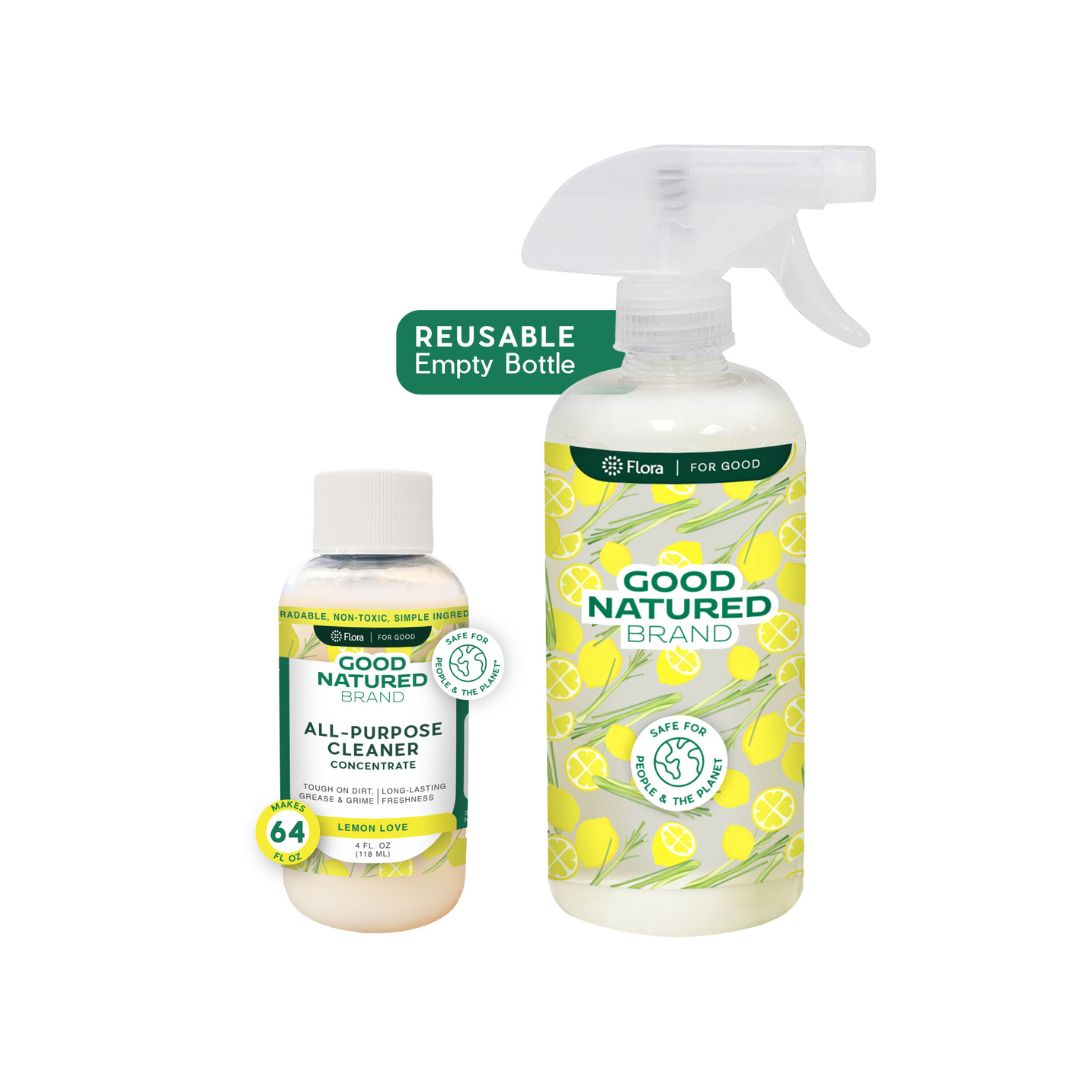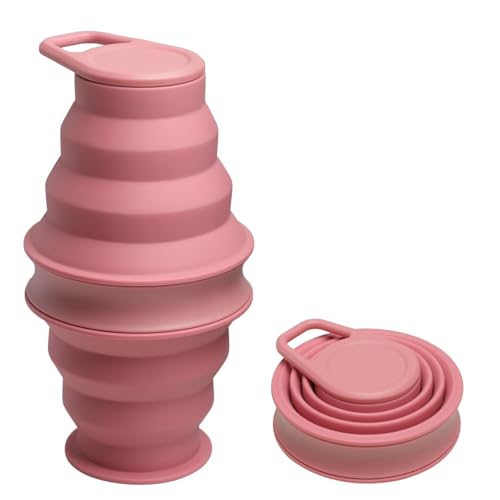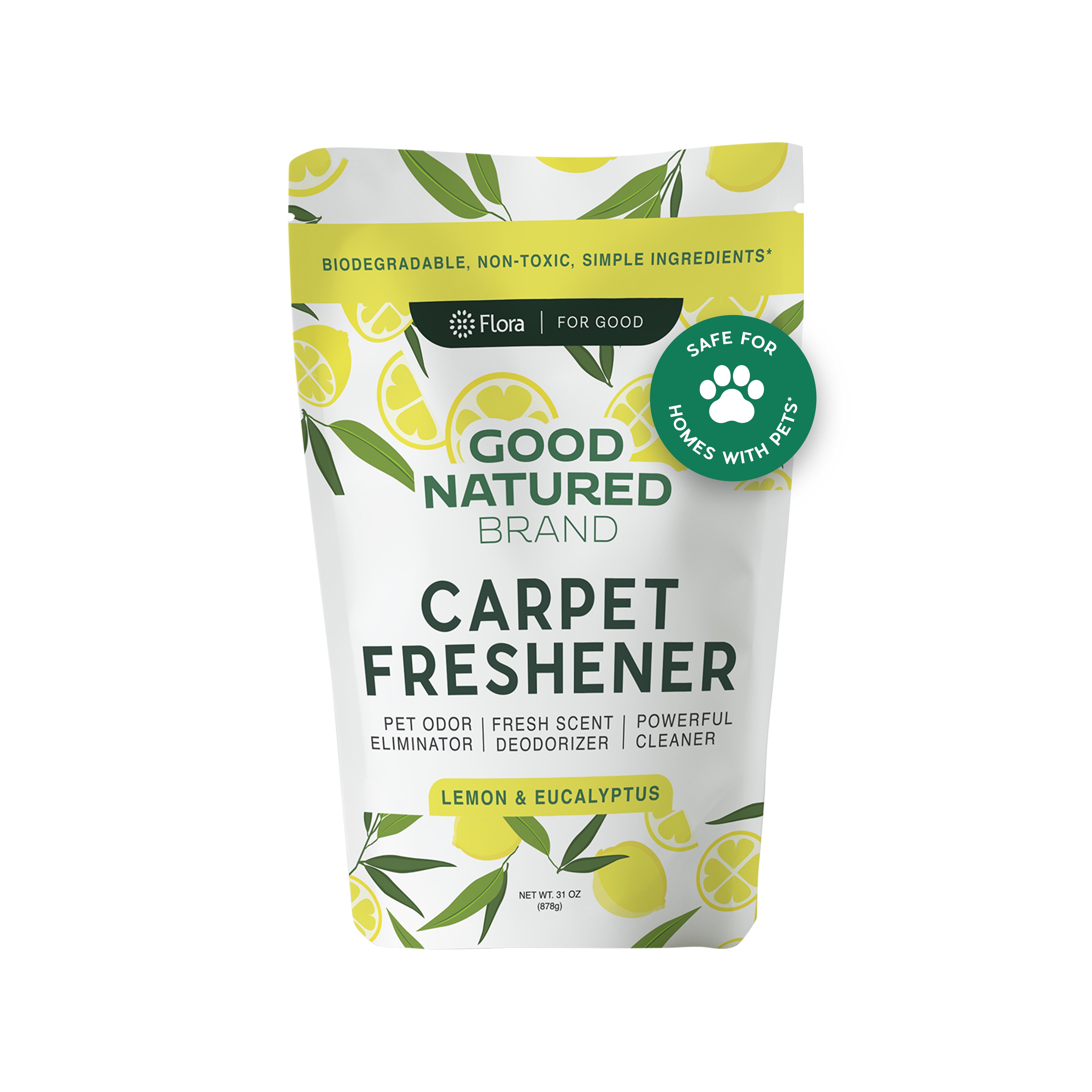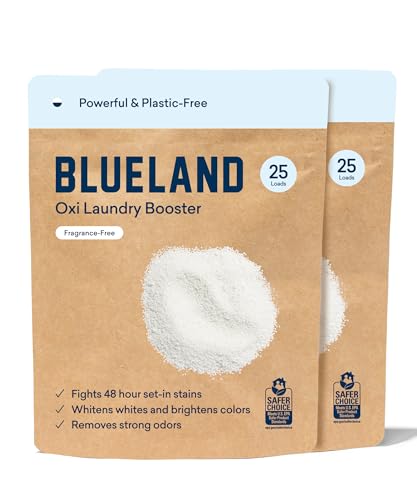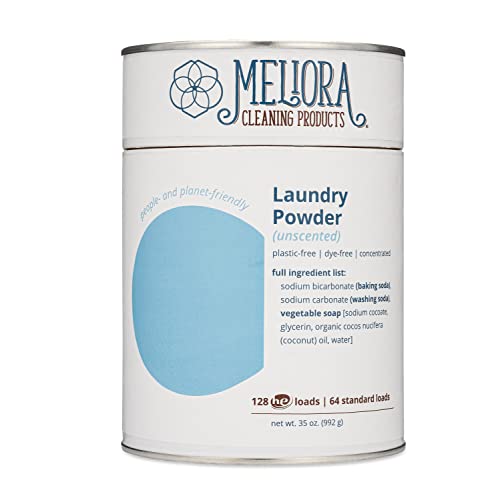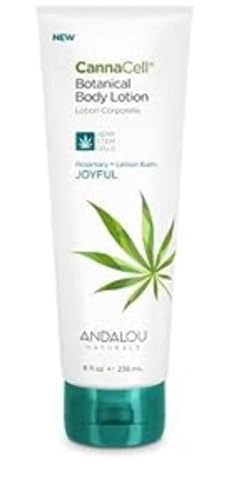
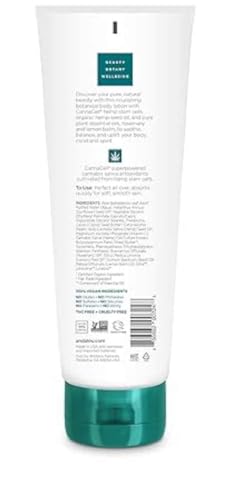
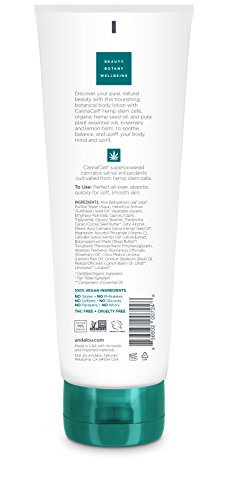
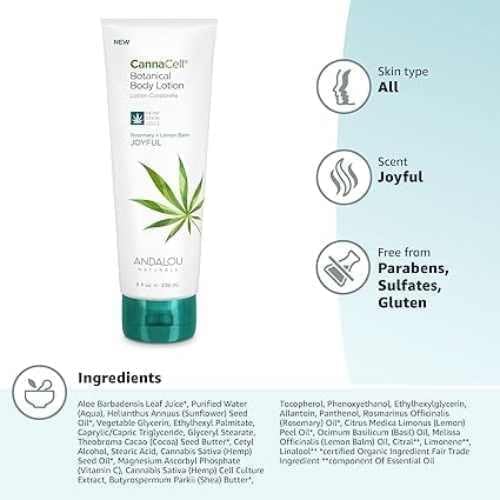
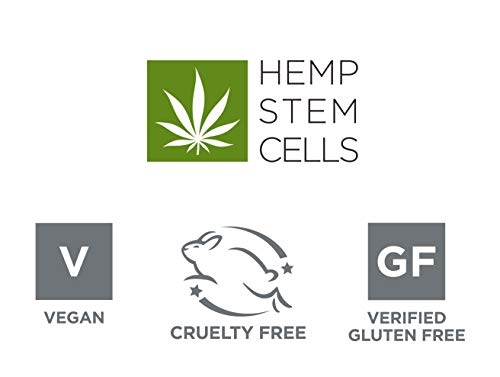
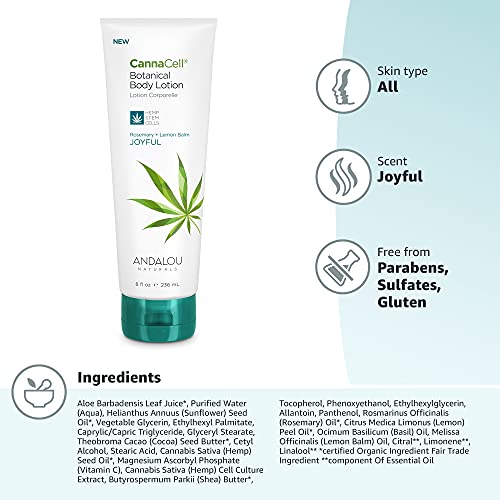
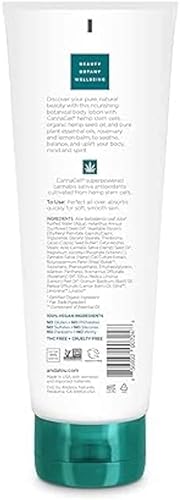
Andalou Naturals Body Lotion - Nourishing Antioxidants, Vegan, Non-GMO - Rosemary & Lemon Balm, 8oz


Citral
High RiskCitral is a naturally occurring scent ingredient primarily used for its lemon-like fragrance in various products, including perfumes, cosmetics, and food. It is derived from essential oils such as lemon myrtle and lemongrass.
Sustai Insights
Citral offers functional benefits as a fragrance component, enhancing product appeal. However, it is associated with a high risk of allergy and irritation, particularly affecting the skin, eyes, and respiratory system. While its carcinogenicity and reproductive toxicity concerns are low, citral's environmental impact as a potential irritant raises caution. Regulatory bodies note usage restrictions due to its allergenic potential, leading to an overall high-risk assessment. Safe practices include patch testing for allergies, and alternatives such as synthetic fragrances may offer lower irritation risks.
Melissa Officinalis (Lemon Balm) Oil
High RiskMelissa officinalis (lemon balm) oil is an essential oil derived from the leaves of the lemon balm plant. It is commonly used in cosmetic and personal care products for its aromatic properties and potential benefits in soothing skin and enhancing relaxation.
Sustai Insights
Lemon balm oil offers functional benefits such as calming effects in aromatherapy and possible antimicrobial properties. However, it carries health risks including low potential for irritation and allergies, with high usage restrictions noted due to regulatory concerns. Environmental risks are minimal, but there are advisories regarding its use. Overall, the ingredient poses a high risk based on current assessments, and caution is advised in its application, especially in products for sensitive populations. Alternatives such as chamomile oil may provide similar benefits with fewer restrictions.
Cannabis Sativa (Hemp) Extract
High RiskCannabis sativa (hemp) extract is derived from the hemp plant, primarily used for its potential therapeutic properties. It contains various cannabinoids, flavonoids, and terpenes, which may contribute to its functional benefits in cosmetic and wellness products. The extract is often sought for its calming and anti-inflammatory effects.
Sustai Insights
Cannabis sativa (hemp) extract offers functional benefits such as anti-inflammatory properties and potential skin-soothing effects. It is derived from sustainably sourced hemp, contributing to its appeal. However, there are health risks associated with its use, including low concerns for carcinogenicity and neurotoxicity. Regulatory restrictions exist in certain jurisdictions, marking it as high risk overall. Safe usage should be practiced, particularly in sensitive applications, and alternatives like hemp seed oil may be considered for specific uses.
Linalool
High RiskLinalool is a terpene commonly found in various plants, particularly in lavender and mint. It is primarily used in products for its fragrance and potential antimicrobial properties. Linalool is also utilized in formulations for its ability to enhance the sensory experience of personal care and household products.
Sustai Insights
Linalool offers functional benefits as a naturally occurring fragrance component and may exhibit antimicrobial properties. However, it presents high allergenic potential, with concerns about skin irritation and sensitization. Environmental risks include contamination issues, though it is not classified as a persistent pollutant. Regulatory bodies have noted the need for careful handling due to its allergenic nature. Overall, despite some beneficial attributes, the ingredient carries a high risk profile, warranting cautious use and consideration of safer alternatives.
Ocimum Basilicum (Sweet Basil) Oil
Medium RiskOcimum basilicum (sweet basil) oil is a volatile oil derived from the leaves of the basil plant. It is commonly used in cosmetics and personal care products for its aromatic properties and potential therapeutic benefits.
Sustai Insights
Sweet basil oil offers functional benefits such as enhancing fragrance and potentially improving skin absorption. However, it carries health risks, including a high likelihood of triggering allergies and moderate concerns regarding carcinogenicity. Environmental risks are low, with no significant pollutant or bioaccumulative properties. Regulatory bodies have placed restrictions on its use, emphasizing cautious application. Overall, this ingredient presents a medium risk profile, warranting safe usage practices and consideration of alternatives.
Citrus Limon (Lemon) Peel Oil
Medium RiskCitrus limon (lemon) peel oil is an essential oil derived from the peel of lemons, commonly used for its aromatic properties and as a natural flavoring agent. It is often included in personal care products for its fragrance and potential antimicrobial properties.
Sustai Insights
Citrus limon (lemon) peel oil offers functional benefits as a natural fragrance and may possess antimicrobial properties, contributing to product stability. However, it is associated with a high allergenic potential, moderate use restrictions, and has been noted for its persistence in the environment. Regulatory warnings indicate restrictions on verified products due to potential irritation and sensitization. The overall risk level is medium, and safe usage practices should be observed to mitigate exposure risks. Alternatives include safer fragrance options or essential oils with lower allergenic profiles.
Cannabis Sativa (Hemp) Seed Oil
Medium RiskCannabis sativa (hemp) seed oil is extracted from the seeds of the hemp plant. It is rich in essential fatty acids and is commonly used in cosmetic and health products for its moisturizing properties and potential nutritional benefits.
Sustai Insights
Hemp seed oil offers functional benefits such as being a moisturizing agent and providing essential fatty acids. It is typically sustainably sourced and biodegradable. Health risks are low, with minimal concerns regarding carcinogenicity, allergies, and reproductive toxicity. Regulatory warnings exist due to moderate use restrictions. Environmental risks are also low, indicating it does not significantly contribute to pollution or bioaccumulation. Overall, the ingredient is assessed as medium risk, and safe usage practices should be followed. Alternatives include other plant-based oils that offer similar benefits.
Rosmarinus Officinalis (Rosemary) Leaf Oil
Medium RiskRosmarinus officinalis (rosemary) leaf oil is extracted from the leaves of the rosemary plant. It is commonly used in cosmetic and personal care products for its aromatic properties and potential preservative benefits due to its antioxidant content.
Sustai Insights
Rosemary leaf oil offers functional benefits such as antimicrobial and antioxidant properties, which can enhance product stability. It is derived from a renewable source and is biodegradable. However, it presents moderate risks of allergic reactions and skin irritation, particularly with enhanced skin absorption. Regulatory bodies have noted restrictions on its usage in specific concentrations. The overall risk level is assessed as medium. Users are advised to follow safe usage practices and may consider alternatives like tocopherols or other natural preservatives.
Glycerin
Medium RiskGlycerin (also called glycerol) is a naturally occurring compound commonly used in personal care and cosmetic products. It functions as a humectant, attracting moisture to the skin, and is also utilized as a solvent and emollient to enhance product texture and stability.
Sustai Insights
Glycerin is valued for its effective moisturizing properties and biodegradability, making it a widely accepted ingredient in formulations. It poses low health risks, including low concerns for carcinogenicity and allergies. However, moderate use restrictions exist due to regulatory guidelines. While glycerin does not significantly contribute to environmental pollution, its production process should be ethically sourced. Overall, glycerin holds a medium risk level, emphasizing the importance of safe usage practices and considering sustainable alternatives.
Limonene
Medium RiskLimonene is a scent ingredient and solvent naturally found in citrus fruits, commonly used in personal care and cleaning products for its fragrant properties. It serves as a flavoring agent and enhances the overall sensory experience of products.
Sustai Insights
Limonene offers functional benefits such as acting as a solvent and fragrance enhancer. However, it carries a high allergenic potential, which can trigger skin or respiratory sensitivities in some individuals. Environmental concerns include moderate persistence and bioaccumulation, along with potential ecotoxicity. Regulatory restrictions necessitate verification in products containing this ingredient. Overall, the risk level is assessed as medium, emphasizing the importance of cautious use, particularly for sensitive populations. Safer alternatives may be considered to mitigate these risks.
Phenoxyethanol
Medium RiskPhenoxyethanol is a preservative used in cosmetics and personal care products to prevent microbial growth and extend shelf life. It is commonly found in formulations such as lotions, creams, and serums.
Sustai Insights
Phenoxyethanol serves effectively as a preservative, ensuring product stability and safety by inhibiting microbial growth. It is considered to have low health risks regarding carcinogenicity, allergies, and reproductive toxicity. However, moderate use restrictions exist, and regulatory bodies have advised caution in specific applications. Environmental concerns include its potential as a pollutant, although it is not highly bioaccumulative. Overall, the ingredient presents a medium risk level, with safe usage practices recommended and alternative preservatives available for those seeking greener options.
Allantoin
Low RiskAllantoin is a naturally occurring nitrogenous compound found in various plants and animals. It is commonly used in cosmetic formulations for its soothing and moisturizing properties, as well as its ability to promote skin cell turnover and healing.
Sustai Insights
Allantoin offers functional benefits such as skin soothing, hydration, and promoting cell regeneration. It is generally recognized as safe, with low concerns regarding carcinogenicity, allergies, and reproductive toxicity. Environmentally, it poses minimal risks, being biodegradable and sustainably sourced. Regulatory bodies do not impose significant restrictions on its use. Overall, the risk level associated with allantoin is low, making it a favorable ingredient in personal care products.
Magnesium Ascorbyl Phosphate
Low RiskMagnesium ascorbyl phosphate is a vitamin C derivative used in cosmetics primarily for its antioxidant properties and skin-brightening effects. It is often included in formulations for its ability to stabilize vitamin C, enhancing its efficacy in skin care products.
Sustai Insights
Magnesium ascorbyl phosphate offers functional benefits as an effective antioxidant and skin-brightening agent, contributing to improved skin appearance. It has a low risk profile concerning health, with minimal concerns regarding carcinogenicity, allergies, and reproductive toxicity. Environmental risks are also low, with no significant pollutant or bioaccumulation potential noted. Regulatory assessments indicate no major restrictions, supporting its safe use in cosmetic products. Overall, the ingredient is assessed as low risk, with safe usage practices recommended for optimal effectiveness.
Theobroma Cacao (Cocoa) Seed Butter
Low RiskTheobroma cacao (cocoa) seed butter is extracted from the roasted seeds of the cocoa plant. It is commonly used in cosmetics and skincare products for its emollient properties, helping to moisturize and soften the skin. Cocoa butter is also known for its stability and resistance to rancidity.
Sustai Insights
Cocoa butter is recognized for its effective moisturizing properties and is sustainably sourced, contributing to its appeal in personal care products. It poses low health risks, with minimal concerns regarding carcinogenicity, allergies, or reproductive toxicity. Environmentally, it does not significantly contribute to pollution or bioaccumulation. Regulatory bodies impose few restrictions, affirming its safety. Overall, the risk associated with cocoa seed butter is low, making it a favorable ingredient in cosmetics. Alternatives include shea butter or plant oils for similar emollient benefits.
Ethylhexyl Palmitate
Low RiskEthylhexyl palmitate is an ester derived from 2-ethylhexanol and palmitic acid. It is commonly used in cosmetic formulations as an emollient, providing a smooth and soft feel to the skin while enhancing product texture and stability.
Sustai Insights
Ethylhexyl palmitate serves effectively as an emollient, contributing to skin smoothness and improving product formulation. It is generally recognized as having low health risks, with concerns primarily related to moderate skin, eye, and respiratory irritation. Environmentally, it poses low pollutant potential and is not bioaccumulative. Regulatory bodies have not placed significant restrictions on its use, indicating a low overall risk. Safe usage practices and alternatives like other natural emollients can be considered, reinforcing its low risk profile.
Stearic Acid
Low RiskStearic acid is a naturally occurring fatty acid commonly found in animal and vegetable fats. It functions primarily as an emulsifier, thickener, and stabilizer in cosmetic and personal care products, providing texture and consistency.
Sustai Insights
Stearic acid offers functional benefits such as effective emulsification and stabilization of formulations. It is derived from renewable sources and is biodegradable, contributing to its sustainability profile. Health risks are low, with minimal concerns regarding carcinogenicity, allergies, or reproductive toxicity. Environmental risks are also low, with no significant pollutants or bioaccumulation concerns noted. Regulatory bodies, including the FDA, do not impose restrictions on its use. Overall, stearic acid is assessed as low risk, and its safe usage practices are well-established, with no significant alternatives needed.
Water
Low RiskWater is a clear, colorless liquid essential for various biological processes. It serves as a solvent in formulations, facilitating the dissolution of other ingredients and enhancing product texture and application. Additionally, water plays a crucial role in hydration and is a key component in many cosmetic and personal care products.
Sustai Insights
Water is an effective solvent and hydrator, contributing to the texture and efficacy of formulations. It is biodegradable and generally regarded as safe, with low concerns regarding carcinogenicity, allergies, and reproductive toxicity. However, excessive water usage can lead to environmental concerns, particularly regarding resource depletion. Regulatory bodies do not impose restrictions on water use in cosmetics. Overall, the risks associated with water are low, making it a safe and essential ingredient.
Panthenol
Low RiskPanthenol, a derivative of vitamin B5, is commonly used in cosmetic formulations for its moisturizing and skin-conditioning properties. It acts as a humectant, helping to retain moisture in the skin and hair, thereby improving hydration and texture.
Sustai Insights
Panthenol offers functional benefits such as effective hydration and skin conditioning, making it valuable in various cosmetic products. It is considered low risk regarding health impacts, with minimal concerns about carcinogenicity, allergies, or reproductive toxicity. Environmental risks are also low, with no significant pollutant or bioaccumulation potential. Regulatory bodies have not imposed restrictions on its use. Safe usage practices include adhering to recommended concentrations. Alternatives like glycerin may provide similar moisturizing benefits, but overall, panthenol is assessed as a low-risk ingredient.
Tocopherol
Low RiskTocopherols are a class of naturally occurring compounds, primarily known for their role as antioxidants. They are commonly used in cosmetic and skincare products to help stabilize formulations and protect ingredients from oxidative damage.
Sustai Insights
Tocopherols provide functional benefits such as antioxidant protection and skin conditioning. They are generally recognized as safe, with low concerns regarding carcinogenicity, allergies, and reproductive toxicity. However, enhanced skin absorption and potential endocrine disruption are noted. Regulatory bodies have not imposed significant restrictions on tocopherols, categorizing the overall risk as low. Safe usage practices should be observed, and while alternatives exist, tocopherols remain a viable option in formulations.
Cetyl Alcohol
Low RiskCetyl alcohol is a long-chain organic alcohol commonly used in cosmetic formulations. It serves as an emollient, emulsifier, and thickening agent, enhancing the texture and stability of products. Cetyl alcohol is derived from natural sources, such as coconut or palm oil, and is often included in creams, lotions, and hair conditioners.
Sustai Insights
Cetyl alcohol offers functional benefits as an emollient and emulsifier, improving product texture and stability. It is biodegradable and sourced from renewable materials, contributing to sustainability. Health risks are minimal, with low concerns for carcinogenicity, allergies, or reproductive toxicity. Environmental impact is also low, with no significant pollutant or bioaccumulation potential. Regulatory bodies have not placed restrictions on its use, indicating a favorable safety profile. Overall, cetyl alcohol is assessed as low risk, and safe usage practices include ensuring proper formulation concentrations.
Ethylhexylglycerin
Low RiskEthylhexylglycerin is a glyceryl ether utilized primarily as a skin-conditioning agent and preservative in cosmetic formulations. It enhances the efficacy of preservatives and serves as a humectant, helping to retain moisture in the skin. This ingredient is commonly found in various personal care products.
Sustai Insights
Ethylhexylglycerin offers functional benefits as an effective preservative and skin-conditioning agent, contributing to product longevity and moisture retention. Health risks are generally low, with minor concerns regarding allergic contact dermatitis and irritant potential. Environmentally, it poses minimal risks, not being recognized as a pollutant or bioaccumulative. Regulatory bodies have imposed few restrictions, indicating its safety for use. Overall, its risk level is assessed as low, making it a viable option in cosmetic formulations. For those seeking alternatives, ingredients like propanediol may serve similar functions with potentially lower irritation profiles.
Glyceryl Monostearate
Low RiskGlyceryl monostearate is a monoester of glycerol and stearic acid, commonly used as an emulsifier and stabilizer in food and cosmetic products. It helps blend oil and water-based ingredients, improving product texture and consistency.
Sustai Insights
Glyceryl monostearate offers functional benefits as an effective emulsifier, enhancing product stability and texture. It is derived from natural sources and is considered biodegradable. Health risks associated with it are low, as it shows no significant carcinogenic, allergenic, or reproductive toxicity effects. Environmental concerns are minimal, with no known pollutant or bioaccumulation issues. Regulatory bodies have not restricted its use, and it is generally regarded as safe. Overall, glyceryl monostearate presents a low risk profile, making it a suitable ingredient in various applications.
Caprylic/Capric Triglyceride
Low RiskCaprylic/capric triglyceride is a mixed triester derived from coconut oil and glycerin, primarily used as an emollient and skin-conditioning agent in cosmetic formulations. It serves to improve the texture and spreadability of products while providing a lightweight, non-greasy feel on the skin.
Sustai Insights
Caprylic/capric triglyceride offers functional benefits as an effective emollient, enhancing skin hydration without clogging pores. It is biodegradable, contributing to sustainability. Health risks are low, with minimal concerns regarding carcinogenicity, allergies, or reproductive toxicity. Environmental impacts are also low, with no known pollutant status. Regulatory assessments indicate no current restrictions. Overall, this ingredient presents a low risk profile, making it a safe choice in cosmetic applications.
Butyrospermum Parkii (Shea) Butter
Low RiskButyrospermum parkii (shea) butter is a vegetable fat derived from the nuts of the shea tree. It is commonly used in cosmetic formulations for its emollient properties, providing moisture and improving skin texture. Additionally, shea butter is known for its ability to enhance the stability of products and deliver a creamy texture.
Sustai Insights
Shea butter offers functional benefits as an effective moisturizer, enhancing skin barrier function and texture. It is sustainably sourced and biodegradable, contributing to eco-friendliness. Health-wise, it is associated with low risks for carcinogenicity, allergies, and reproductive toxicity. Environmental impacts are minimal, with no significant pollutant potential identified. Regulatory assessments indicate no current restrictions. Overall, the ingredient presents a low risk, making it a favorable choice in cosmetic formulations.
Helianthus Annuus (Sunflower) Seed Oil
Low RiskHelianthus annuus (sunflower) seed oil is derived from the seeds of the sunflower plant. It serves primarily as an emollient and moisturizer in cosmetic formulations, helping to maintain skin hydration and improve texture.
Sustai Insights
Sunflower seed oil is effective as an emollient, providing moisture and improving skin texture while being biodegradable and sustainably sourced. It poses low health risks, including negligible concerns for carcinogenicity, allergies, or reproductive toxicity. Environmentally, it does not significantly contribute to pollution or bioaccumulation. Regulatory bodies currently do not list any advisories for this ingredient. Overall, it is assessed as low risk, with safe usage practices recommended. Alternatives include oils like jojoba or almond oil for those seeking different properties.
Aloe Barbadensis (Aloe Vera) Leaf Juice
Low RiskAloe barbadensis (aloe vera) leaf juice is derived from the succulent aloe vera plant, known for its hydrating and soothing properties. It is commonly used in cosmetic formulations for its moisturizing effects and is often included in products aimed at skin care and healing.
Sustai Insights
Aloe vera leaf juice offers functional benefits as a moisturizer and skin soothing agent, while being sustainably sourced and biodegradable. Health risks are low, with minimal concerns regarding carcinogenicity, allergies, and reproductive toxicity. Environmental impact is also low, with no significant pollutants identified. Regulatory agencies impose few restrictions. Overall, the ingredient poses a low risk, making it a favorable choice in cosmetic formulations.
Citral
High RiskCitral is a naturally occurring scent ingredient primarily used for its lemon-like fragrance in various products, including perfumes, cosmetics, and food. It is derived from essential oils such as lemon myrtle and lemongrass.
Sustai Insights
Citral offers functional benefits as a fragrance component, enhancing product appeal. However, it is associated with a high risk of allergy and irritation, particularly affecting the skin, eyes, and respiratory system. While its carcinogenicity and reproductive toxicity concerns are low, citral's environmental impact as a potential irritant raises caution. Regulatory bodies note usage restrictions due to its allergenic potential, leading to an overall high-risk assessment. Safe practices include patch testing for allergies, and alternatives such as synthetic fragrances may offer lower irritation risks.
Allantoin
Low RiskAllantoin is a naturally occurring nitrogenous compound found in various plants and animals. It is commonly used in cosmetic formulations for its soothing and moisturizing properties, as well as its ability to promote skin cell turnover and healing.
Sustai Insights
Allantoin offers functional benefits such as skin soothing, hydration, and promoting cell regeneration. It is generally recognized as safe, with low concerns regarding carcinogenicity, allergies, and reproductive toxicity. Environmentally, it poses minimal risks, being biodegradable and sustainably sourced. Regulatory bodies do not impose significant restrictions on its use. Overall, the risk level associated with allantoin is low, making it a favorable ingredient in personal care products.
Ocimum Basilicum (Sweet Basil) Oil
Medium RiskOcimum basilicum (sweet basil) oil is a volatile oil derived from the leaves of the basil plant. It is commonly used in cosmetics and personal care products for its aromatic properties and potential therapeutic benefits.
Sustai Insights
Sweet basil oil offers functional benefits such as enhancing fragrance and potentially improving skin absorption. However, it carries health risks, including a high likelihood of triggering allergies and moderate concerns regarding carcinogenicity. Environmental risks are low, with no significant pollutant or bioaccumulative properties. Regulatory bodies have placed restrictions on its use, emphasizing cautious application. Overall, this ingredient presents a medium risk profile, warranting safe usage practices and consideration of alternatives.
Magnesium Ascorbyl Phosphate
Low RiskMagnesium ascorbyl phosphate is a vitamin C derivative used in cosmetics primarily for its antioxidant properties and skin-brightening effects. It is often included in formulations for its ability to stabilize vitamin C, enhancing its efficacy in skin care products.
Sustai Insights
Magnesium ascorbyl phosphate offers functional benefits as an effective antioxidant and skin-brightening agent, contributing to improved skin appearance. It has a low risk profile concerning health, with minimal concerns regarding carcinogenicity, allergies, and reproductive toxicity. Environmental risks are also low, with no significant pollutant or bioaccumulation potential noted. Regulatory assessments indicate no major restrictions, supporting its safe use in cosmetic products. Overall, the ingredient is assessed as low risk, with safe usage practices recommended for optimal effectiveness.
Theobroma Cacao (Cocoa) Seed Butter
Low RiskTheobroma cacao (cocoa) seed butter is extracted from the roasted seeds of the cocoa plant. It is commonly used in cosmetics and skincare products for its emollient properties, helping to moisturize and soften the skin. Cocoa butter is also known for its stability and resistance to rancidity.
Sustai Insights
Cocoa butter is recognized for its effective moisturizing properties and is sustainably sourced, contributing to its appeal in personal care products. It poses low health risks, with minimal concerns regarding carcinogenicity, allergies, or reproductive toxicity. Environmentally, it does not significantly contribute to pollution or bioaccumulation. Regulatory bodies impose few restrictions, affirming its safety. Overall, the risk associated with cocoa seed butter is low, making it a favorable ingredient in cosmetics. Alternatives include shea butter or plant oils for similar emollient benefits.
Citrus Limon (Lemon) Peel Oil
Medium RiskCitrus limon (lemon) peel oil is an essential oil derived from the peel of lemons, commonly used for its aromatic properties and as a natural flavoring agent. It is often included in personal care products for its fragrance and potential antimicrobial properties.
Sustai Insights
Citrus limon (lemon) peel oil offers functional benefits as a natural fragrance and may possess antimicrobial properties, contributing to product stability. However, it is associated with a high allergenic potential, moderate use restrictions, and has been noted for its persistence in the environment. Regulatory warnings indicate restrictions on verified products due to potential irritation and sensitization. The overall risk level is medium, and safe usage practices should be observed to mitigate exposure risks. Alternatives include safer fragrance options or essential oils with lower allergenic profiles.
Cannabis Sativa (Hemp) Seed Oil
Medium RiskCannabis sativa (hemp) seed oil is extracted from the seeds of the hemp plant. It is rich in essential fatty acids and is commonly used in cosmetic and health products for its moisturizing properties and potential nutritional benefits.
Sustai Insights
Hemp seed oil offers functional benefits such as being a moisturizing agent and providing essential fatty acids. It is typically sustainably sourced and biodegradable. Health risks are low, with minimal concerns regarding carcinogenicity, allergies, and reproductive toxicity. Regulatory warnings exist due to moderate use restrictions. Environmental risks are also low, indicating it does not significantly contribute to pollution or bioaccumulation. Overall, the ingredient is assessed as medium risk, and safe usage practices should be followed. Alternatives include other plant-based oils that offer similar benefits.
Ethylhexyl Palmitate
Low RiskEthylhexyl palmitate is an ester derived from 2-ethylhexanol and palmitic acid. It is commonly used in cosmetic formulations as an emollient, providing a smooth and soft feel to the skin while enhancing product texture and stability.
Sustai Insights
Ethylhexyl palmitate serves effectively as an emollient, contributing to skin smoothness and improving product formulation. It is generally recognized as having low health risks, with concerns primarily related to moderate skin, eye, and respiratory irritation. Environmentally, it poses low pollutant potential and is not bioaccumulative. Regulatory bodies have not placed significant restrictions on its use, indicating a low overall risk. Safe usage practices and alternatives like other natural emollients can be considered, reinforcing its low risk profile.
Rosmarinus Officinalis (Rosemary) Leaf Oil
Medium RiskRosmarinus officinalis (rosemary) leaf oil is extracted from the leaves of the rosemary plant. It is commonly used in cosmetic and personal care products for its aromatic properties and potential preservative benefits due to its antioxidant content.
Sustai Insights
Rosemary leaf oil offers functional benefits such as antimicrobial and antioxidant properties, which can enhance product stability. It is derived from a renewable source and is biodegradable. However, it presents moderate risks of allergic reactions and skin irritation, particularly with enhanced skin absorption. Regulatory bodies have noted restrictions on its usage in specific concentrations. The overall risk level is assessed as medium. Users are advised to follow safe usage practices and may consider alternatives like tocopherols or other natural preservatives.
Melissa Officinalis (Lemon Balm) Oil
High RiskMelissa officinalis (lemon balm) oil is an essential oil derived from the leaves of the lemon balm plant. It is commonly used in cosmetic and personal care products for its aromatic properties and potential benefits in soothing skin and enhancing relaxation.
Sustai Insights
Lemon balm oil offers functional benefits such as calming effects in aromatherapy and possible antimicrobial properties. However, it carries health risks including low potential for irritation and allergies, with high usage restrictions noted due to regulatory concerns. Environmental risks are minimal, but there are advisories regarding its use. Overall, the ingredient poses a high risk based on current assessments, and caution is advised in its application, especially in products for sensitive populations. Alternatives such as chamomile oil may provide similar benefits with fewer restrictions.
Cannabis Sativa (Hemp) Extract
High RiskCannabis sativa (hemp) extract is derived from the hemp plant, primarily used for its potential therapeutic properties. It contains various cannabinoids, flavonoids, and terpenes, which may contribute to its functional benefits in cosmetic and wellness products. The extract is often sought for its calming and anti-inflammatory effects.
Sustai Insights
Cannabis sativa (hemp) extract offers functional benefits such as anti-inflammatory properties and potential skin-soothing effects. It is derived from sustainably sourced hemp, contributing to its appeal. However, there are health risks associated with its use, including low concerns for carcinogenicity and neurotoxicity. Regulatory restrictions exist in certain jurisdictions, marking it as high risk overall. Safe usage should be practiced, particularly in sensitive applications, and alternatives like hemp seed oil may be considered for specific uses.
Stearic Acid
Low RiskStearic acid is a naturally occurring fatty acid commonly found in animal and vegetable fats. It functions primarily as an emulsifier, thickener, and stabilizer in cosmetic and personal care products, providing texture and consistency.
Sustai Insights
Stearic acid offers functional benefits such as effective emulsification and stabilization of formulations. It is derived from renewable sources and is biodegradable, contributing to its sustainability profile. Health risks are low, with minimal concerns regarding carcinogenicity, allergies, or reproductive toxicity. Environmental risks are also low, with no significant pollutants or bioaccumulation concerns noted. Regulatory bodies, including the FDA, do not impose restrictions on its use. Overall, stearic acid is assessed as low risk, and its safe usage practices are well-established, with no significant alternatives needed.
Water
Low RiskWater is a clear, colorless liquid essential for various biological processes. It serves as a solvent in formulations, facilitating the dissolution of other ingredients and enhancing product texture and application. Additionally, water plays a crucial role in hydration and is a key component in many cosmetic and personal care products.
Sustai Insights
Water is an effective solvent and hydrator, contributing to the texture and efficacy of formulations. It is biodegradable and generally regarded as safe, with low concerns regarding carcinogenicity, allergies, and reproductive toxicity. However, excessive water usage can lead to environmental concerns, particularly regarding resource depletion. Regulatory bodies do not impose restrictions on water use in cosmetics. Overall, the risks associated with water are low, making it a safe and essential ingredient.
Glycerin
Medium RiskGlycerin (also called glycerol) is a naturally occurring compound commonly used in personal care and cosmetic products. It functions as a humectant, attracting moisture to the skin, and is also utilized as a solvent and emollient to enhance product texture and stability.
Sustai Insights
Glycerin is valued for its effective moisturizing properties and biodegradability, making it a widely accepted ingredient in formulations. It poses low health risks, including low concerns for carcinogenicity and allergies. However, moderate use restrictions exist due to regulatory guidelines. While glycerin does not significantly contribute to environmental pollution, its production process should be ethically sourced. Overall, glycerin holds a medium risk level, emphasizing the importance of safe usage practices and considering sustainable alternatives.
Limonene
Medium RiskLimonene is a scent ingredient and solvent naturally found in citrus fruits, commonly used in personal care and cleaning products for its fragrant properties. It serves as a flavoring agent and enhances the overall sensory experience of products.
Sustai Insights
Limonene offers functional benefits such as acting as a solvent and fragrance enhancer. However, it carries a high allergenic potential, which can trigger skin or respiratory sensitivities in some individuals. Environmental concerns include moderate persistence and bioaccumulation, along with potential ecotoxicity. Regulatory restrictions necessitate verification in products containing this ingredient. Overall, the risk level is assessed as medium, emphasizing the importance of cautious use, particularly for sensitive populations. Safer alternatives may be considered to mitigate these risks.
Linalool
High RiskLinalool is a terpene commonly found in various plants, particularly in lavender and mint. It is primarily used in products for its fragrance and potential antimicrobial properties. Linalool is also utilized in formulations for its ability to enhance the sensory experience of personal care and household products.
Sustai Insights
Linalool offers functional benefits as a naturally occurring fragrance component and may exhibit antimicrobial properties. However, it presents high allergenic potential, with concerns about skin irritation and sensitization. Environmental risks include contamination issues, though it is not classified as a persistent pollutant. Regulatory bodies have noted the need for careful handling due to its allergenic nature. Overall, despite some beneficial attributes, the ingredient carries a high risk profile, warranting cautious use and consideration of safer alternatives.
Panthenol
Low RiskPanthenol, a derivative of vitamin B5, is commonly used in cosmetic formulations for its moisturizing and skin-conditioning properties. It acts as a humectant, helping to retain moisture in the skin and hair, thereby improving hydration and texture.
Sustai Insights
Panthenol offers functional benefits such as effective hydration and skin conditioning, making it valuable in various cosmetic products. It is considered low risk regarding health impacts, with minimal concerns about carcinogenicity, allergies, or reproductive toxicity. Environmental risks are also low, with no significant pollutant or bioaccumulation potential. Regulatory bodies have not imposed restrictions on its use. Safe usage practices include adhering to recommended concentrations. Alternatives like glycerin may provide similar moisturizing benefits, but overall, panthenol is assessed as a low-risk ingredient.
Tocopherol
Low RiskTocopherols are a class of naturally occurring compounds, primarily known for their role as antioxidants. They are commonly used in cosmetic and skincare products to help stabilize formulations and protect ingredients from oxidative damage.
Sustai Insights
Tocopherols provide functional benefits such as antioxidant protection and skin conditioning. They are generally recognized as safe, with low concerns regarding carcinogenicity, allergies, and reproductive toxicity. However, enhanced skin absorption and potential endocrine disruption are noted. Regulatory bodies have not imposed significant restrictions on tocopherols, categorizing the overall risk as low. Safe usage practices should be observed, and while alternatives exist, tocopherols remain a viable option in formulations.
Cetyl Alcohol
Low RiskCetyl alcohol is a long-chain organic alcohol commonly used in cosmetic formulations. It serves as an emollient, emulsifier, and thickening agent, enhancing the texture and stability of products. Cetyl alcohol is derived from natural sources, such as coconut or palm oil, and is often included in creams, lotions, and hair conditioners.
Sustai Insights
Cetyl alcohol offers functional benefits as an emollient and emulsifier, improving product texture and stability. It is biodegradable and sourced from renewable materials, contributing to sustainability. Health risks are minimal, with low concerns for carcinogenicity, allergies, or reproductive toxicity. Environmental impact is also low, with no significant pollutant or bioaccumulation potential. Regulatory bodies have not placed restrictions on its use, indicating a favorable safety profile. Overall, cetyl alcohol is assessed as low risk, and safe usage practices include ensuring proper formulation concentrations.
Phenoxyethanol
Medium RiskPhenoxyethanol is a preservative used in cosmetics and personal care products to prevent microbial growth and extend shelf life. It is commonly found in formulations such as lotions, creams, and serums.
Sustai Insights
Phenoxyethanol serves effectively as a preservative, ensuring product stability and safety by inhibiting microbial growth. It is considered to have low health risks regarding carcinogenicity, allergies, and reproductive toxicity. However, moderate use restrictions exist, and regulatory bodies have advised caution in specific applications. Environmental concerns include its potential as a pollutant, although it is not highly bioaccumulative. Overall, the ingredient presents a medium risk level, with safe usage practices recommended and alternative preservatives available for those seeking greener options.
Ethylhexylglycerin
Low RiskEthylhexylglycerin is a glyceryl ether utilized primarily as a skin-conditioning agent and preservative in cosmetic formulations. It enhances the efficacy of preservatives and serves as a humectant, helping to retain moisture in the skin. This ingredient is commonly found in various personal care products.
Sustai Insights
Ethylhexylglycerin offers functional benefits as an effective preservative and skin-conditioning agent, contributing to product longevity and moisture retention. Health risks are generally low, with minor concerns regarding allergic contact dermatitis and irritant potential. Environmentally, it poses minimal risks, not being recognized as a pollutant or bioaccumulative. Regulatory bodies have imposed few restrictions, indicating its safety for use. Overall, its risk level is assessed as low, making it a viable option in cosmetic formulations. For those seeking alternatives, ingredients like propanediol may serve similar functions with potentially lower irritation profiles.
Glyceryl Monostearate
Low RiskGlyceryl monostearate is a monoester of glycerol and stearic acid, commonly used as an emulsifier and stabilizer in food and cosmetic products. It helps blend oil and water-based ingredients, improving product texture and consistency.
Sustai Insights
Glyceryl monostearate offers functional benefits as an effective emulsifier, enhancing product stability and texture. It is derived from natural sources and is considered biodegradable. Health risks associated with it are low, as it shows no significant carcinogenic, allergenic, or reproductive toxicity effects. Environmental concerns are minimal, with no known pollutant or bioaccumulation issues. Regulatory bodies have not restricted its use, and it is generally regarded as safe. Overall, glyceryl monostearate presents a low risk profile, making it a suitable ingredient in various applications.
Caprylic/Capric Triglyceride
Low RiskCaprylic/capric triglyceride is a mixed triester derived from coconut oil and glycerin, primarily used as an emollient and skin-conditioning agent in cosmetic formulations. It serves to improve the texture and spreadability of products while providing a lightweight, non-greasy feel on the skin.
Sustai Insights
Caprylic/capric triglyceride offers functional benefits as an effective emollient, enhancing skin hydration without clogging pores. It is biodegradable, contributing to sustainability. Health risks are low, with minimal concerns regarding carcinogenicity, allergies, or reproductive toxicity. Environmental impacts are also low, with no known pollutant status. Regulatory assessments indicate no current restrictions. Overall, this ingredient presents a low risk profile, making it a safe choice in cosmetic applications.
Butyrospermum Parkii (Shea) Butter
Low RiskButyrospermum parkii (shea) butter is a vegetable fat derived from the nuts of the shea tree. It is commonly used in cosmetic formulations for its emollient properties, providing moisture and improving skin texture. Additionally, shea butter is known for its ability to enhance the stability of products and deliver a creamy texture.
Sustai Insights
Shea butter offers functional benefits as an effective moisturizer, enhancing skin barrier function and texture. It is sustainably sourced and biodegradable, contributing to eco-friendliness. Health-wise, it is associated with low risks for carcinogenicity, allergies, and reproductive toxicity. Environmental impacts are minimal, with no significant pollutant potential identified. Regulatory assessments indicate no current restrictions. Overall, the ingredient presents a low risk, making it a favorable choice in cosmetic formulations.
Helianthus Annuus (Sunflower) Seed Oil
Low RiskHelianthus annuus (sunflower) seed oil is derived from the seeds of the sunflower plant. It serves primarily as an emollient and moisturizer in cosmetic formulations, helping to maintain skin hydration and improve texture.
Sustai Insights
Sunflower seed oil is effective as an emollient, providing moisture and improving skin texture while being biodegradable and sustainably sourced. It poses low health risks, including negligible concerns for carcinogenicity, allergies, or reproductive toxicity. Environmentally, it does not significantly contribute to pollution or bioaccumulation. Regulatory bodies currently do not list any advisories for this ingredient. Overall, it is assessed as low risk, with safe usage practices recommended. Alternatives include oils like jojoba or almond oil for those seeking different properties.
Aloe Barbadensis (Aloe Vera) Leaf Juice
Low RiskAloe barbadensis (aloe vera) leaf juice is derived from the succulent aloe vera plant, known for its hydrating and soothing properties. It is commonly used in cosmetic formulations for its moisturizing effects and is often included in products aimed at skin care and healing.
Sustai Insights
Aloe vera leaf juice offers functional benefits as a moisturizer and skin soothing agent, while being sustainably sourced and biodegradable. Health risks are low, with minimal concerns regarding carcinogenicity, allergies, and reproductive toxicity. Environmental impact is also low, with no significant pollutants identified. Regulatory agencies impose few restrictions. Overall, the ingredient poses a low risk, making it a favorable choice in cosmetic formulations.
Experience the joy of natural beauty with Andalou Naturals CannaCell Body Lotion. This 8-ounce body moisturizer harnesses the power of botanical ingredients to nourish and hydrate all skin types, leaving you feeling refreshed and uplifted.
- Nourishing Hydration: Enriched with a blend of vitamins and essential fatty acids, this lotion deeply hydrates while promoting healthy skin.
- Natural Antioxidants: Featuring proprietary CannaCell hemp stem cells, it helps combat free radicals and premature aging caused by environmental stressors.
- Gentle and Vegan: Made with 100% vegan ingredients, this lotion is free from sulfates, parabens, and phthalates, ensuring a safe choice for your skin.
- Soothing Aroma: The delightful blend of rosemary and lemon balm not only uplifts your spirit but also provides a calming experience during application.
- Easy Application: Simply apply to clean, dry skin for optimal absorption. Perfect for daily use after showering or whenever your skin needs extra moisture.
Choose Andalou Naturals for a body lotion that embodies sustainability and health-conscious living.
Subscribe & Save with Sustai
- Best Price Guarantee: Always enjoy the lowest prices on sustainable home essentials.
- No Surprises: We’ll notify you before shipping. No hidden fees, ever.
- You’re in Charge: Change, pause, or cancel your subscription anytime with ease.
- Eco-Friendly Deliveries: Our grouped shipments mean less packaging and lower emissions.
Join us on a sustainable journey. Special offers for a limited time! Prices and promotions may change.
Recommended Products
Experience the joy of natural beauty with Andalou Naturals CannaCell Body Lotion. This 8-ounce body moisturizer harnesses the power of botanical ingredients to nourish and hydrate all skin types, leaving you feeling refreshed and uplifted.
- Nourishing Hydration: Enriched with a blend of vitamins and essential fatty acids, this lotion deeply hydrates while promoting healthy skin.
- Natural Antioxidants: Featuring proprietary CannaCell hemp stem cells, it helps combat free radicals and premature aging caused by environmental stressors.
- Gentle and Vegan: Made with 100% vegan ingredients, this lotion is free from sulfates, parabens, and phthalates, ensuring a safe choice for your skin.
- Soothing Aroma: The delightful blend of rosemary and lemon balm not only uplifts your spirit but also provides a calming experience during application.
- Easy Application: Simply apply to clean, dry skin for optimal absorption. Perfect for daily use after showering or whenever your skin needs extra moisture.
Choose Andalou Naturals for a body lotion that embodies sustainability and health-conscious living.

You can have at most 2 Sustainable Steals products in your cart
Customer Reviews
Customers’ View
Customers appreciate the nourishing and soothing qualities of the Body Lotion | Joyful Scent. Many highlight the delightful herbal scent, describing it as lovely and uplifting, which contributes to a pleasant application experience. The lotion is frequently praised for its effective moisturizing properties, with users noting it keeps skin supple and soft, even in challenging climates. Additionally, customers value the product's clean, natural ingredients, emphasizing its bioavailable vegan formulation and absence of harmful additives. This aligns well with their eco-conscious and health-focused values. Overall, users find this body lotion effective in enhancing skin health while adhering to their sustainable lifestyle choices.
AI-generated from the text of customer reviewsThis product has no reviews yet.
